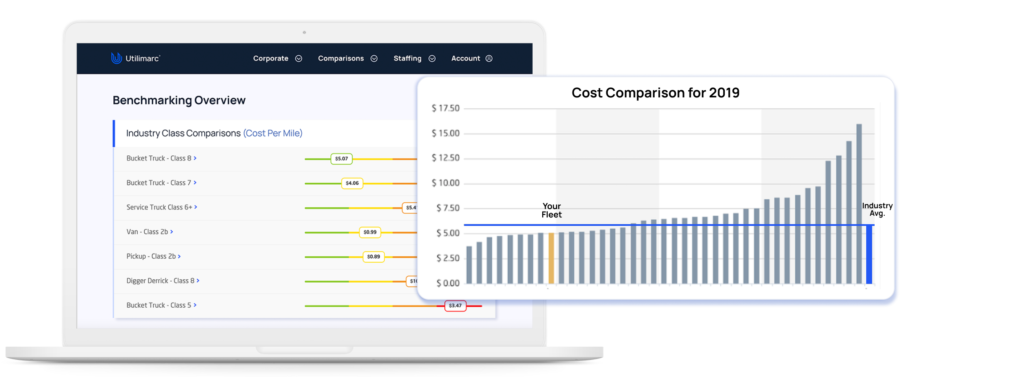
5 Benefits of Benchmarking Fleet Operations
Have you ever wondered where your fleet stacks up against industry averages? From operational data and fleet size, to mechanic performance and quartile performance – benchmarking your fleet allows you to better understand your data from a big-picture view. Your fleet’s benchmark data is a key piece of information that gives you an insight into how your fleet is performing year over year – specifically when it comes to asset performance and operational costs.
In this article, we’ll cover what a true peer-to-peer benchmark is, what insights you can gather from a benchmark as well as the benefits of benchmarking driver behavior.
Read on for more.
What is an accurate peer-to-peer benchmark?
An accurate peer-to-peer benchmark helps you understand where you stand within your industry. It delves into your data and measures whether or not your fleet meets the industry norm. Benchmark data can also shed light on how today’s actions might affect your finances and operations down the line.
A benchmarking application should standardize your data, allowing you to clearly set data driven goals and objectives that aid in the optimization of your fleet, as well as shed light on how you stack up internally and against other fleets industry wide.
By identifying areas that you’re not doing well in, you can drive change in the following year by using a fleet analytics solution powered with telematics and operational data to measure daily performance against goals set by benchmark data.

What insights can fleet managers gather from a benchmark?
Benchmarking your fleet data can provide you with many valuable insights when it comes to bettering your fleet management strategy. And it’s not just insights about your fleet from a company-wide view; rather when you benchmark your fleet against the industry standard, you can find anomalies, performance standards and so much more.
Many fleet managers use benchmarking data to hone in on the assets that they spend the most money on. More often than not, these fleet assets are what drive the most change within their organizations. They could be an outlier in quartile performance based on the industry average; whether that be in utilization or mechanic hours. One can even begin to understand what key performance indicators point to the reason as to why a certain vehicle class in their fleet may be within the limits of an unsatisfactory quartile.
Whether or not you are using industry benchmarking data, beginning by doing an internal benchmark can aid in identifying mechanic productivity or can help your fleet improve driver behavior by understanding year over year performance.
What are the benefits of benchmarking your fleet?
What exactly are the benefits of benchmarking your fleet? Using your benchmark data, you’ll be able to understand your fleet from the inside out – but don’t just take our word for it. Benchmarking data will also give you:
1. The ability to see where you stand within a standardized field
Have you ever wondered whether your data was being used in a clean, high-quality, industry-wide comparison? An industry benchmark is a way of comparing best practices against what you’re already doing with your fleet’s operations. You’ll be able to better identify gaps in performance and potentially gain a competitive advantage from simply understanding where you measure up.
A benchmark can be applied to any facet of your fleet’s operations. From maintenance to vehicle class, process to product – a benchmark is always a good idea.
2. A keen eye to identify areas for improvement
There will always be new ways to better optimize your fleet and operational standards. Understanding your fleet from the bottom up by deeply diving into your data can help you create and measure goals in the future.
From financials to operational process, you can assess what others in your industry are doing (peers or competitors), see what they’re (or you’re) doing right and apply it to your own strategy to make your fleet more competitive.
3. The ability to understand fleet industry data trends
The fleet industry has trends like any other, and it’s just as key to stay on top of them.
Take the Ford Crown Victoria for example. As the Crown Victoria model was removed from most police fleets, they began moving from sedans to marked SUVs. Although it was cheap, spacious and powerful enough for its use, it was extremely dated in regard to updated technology and power capacity. It was slower and less easy to maneuver than other four-doors, as well as being prone to gas tank ruptures.
Because of this, Ford began to make better options for police fleets, and as a result – the move from Crown Victoria to other models like the Interceptor, F150 or Edge was an easy one.
4. The ability to see mechanic productivity at a high level
Are your mechanics measuring their time effectively and tracking their time to a unit or are they generalizing their reported hours? How many vehicles or assets are they expected to support?
Looking at your maintenance – outsourced or in-house – from a high level can help you answer these questions and give you a leg up when it comes to making decisions for your fleet.
5. The insights you need to slice data to meet your fleet’s exact needs
Sometimes a comparison doesn’t help – like when you compare a similar class of vehicle rather than the exact same. Or perhaps if you’re comparing your LA-based fleet to one in the Midwest that experiences more rust because of harsher weather conditions. When you can create like to like comparisons, your data becomes much more effective.
Ready to create your own benchmark?
Utilizing a benchmark can drive real change within your fleet. From understanding where you measure up to your peers or being able to look into your quartile performance year over year, the insights derived from an accurate company-wide and peer-to-peer benchmark are incredibly impactful.
If you’re ready to create your own benchmark, schedule a demo with one of our analysts to learn more about how you can drive real change in your organization.

Jessica Adams
Manager of Customer Success
Jessica Adams is the manager of Customer Success at Utilimarc. She began her career with Utilimarc six years ago after graduating from the University of St. Thomas. Jessica specializes in benchmarking and enjoys creating custom reporting for clients. See more from Jessica


